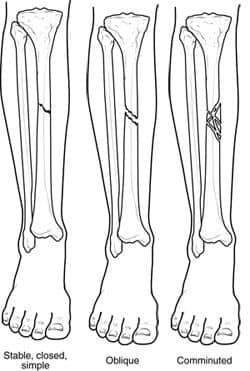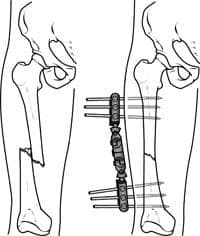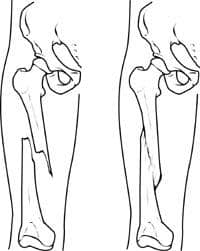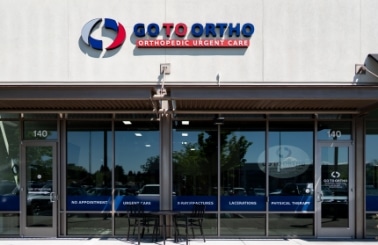A fracture is the same thing as a broken bone. There is no difference. The word fracture is the clinical term for a break in a bone. A fracture can range in severity from a hairline fracture, which is a small crack in the bone, to a compound fracture, where the broken bone punctures the skin. Bone can fracture crosswise, lengthwise, in several places, or into many pieces.
Fractures are common home injuries, sports injuries, and workplace injuries that may involve the ankle, foot, hand, hip, knee, scaphoid (part of the carpal navicular, located in the palm), shoulder, or wrist.

What Causes a Bone Fracture?
The most common causes of bone fractures are:
- Trauma – a fall, a motor vehicle accident, or a tackle during a football game
- Osteoporosis – a medical condition that weakens bones and makes them more likely to break
- Overuse – repetitive motion can tire muscles and place more force on the bone (e.g., stress fractures in athletes)
What Are Symptoms of a Fracture?
The most common symptoms of a fracture or broken bone include:
- A snap or grinding sound when the injury occurs
- Intense pain when the injury happens
- Pain that worsens when you move or touch the injured area
- Dizziness or passing out
- Feeling chilly from the shock
- Swelling, redness, and bruising around the injured area
- Difficulty supporting weight with the injured area
- Visible deformity in the injured area
- A broken bone poking through the skin
Are There Different Types of Bone Fractures?
A bone can fracture in different ways. Some common fracture types include:
- Comminute Fracture – a bone breaks into several fragments; these are serious breaks that often occur following a car accident or another serious event
- Greenstick Fracture – these fractures most often occur in children whose bones have yet to develop fully; a child’s soft bones may not break when dealt a significant blow, causing the bone to bend
- Oblique Fracture – a break that is curved or at an angle to the bone
- Open, Compound Fracture – the skin may be pierced by the bone or by a blow that breaks the skin at the time of the fracture; the bone may not be visible in the wound
- Pathologic Fracture – is a bone fracture that results from a disease where the condition weakens the bones so much that they fracture easily (e.g., osteoporosis)
- Stable Fracture – broken ends of the bone line up and are barely out of place
- Stress Fracture – is a hairline fracture in the bone
- Transverse Fracture – a bone breaks at a 90-degree angle to the long axis of the bone, as the result of a blow perpendicular to the bone
Some common fracture types are shown here.

How Do You Treat a Fracture?
There are several treatment options available for bone fractures. Treatment options usually depend on the extent of the injury.
Cast Immobilization. A plaster or fiberglass cast is the most common type of fracture treatment because most broken bones can heal successfully once they have been repositioned and a cast has been applied to keep the broken ends in proper position while they heal.
Functional Cast or Brace. The cast or brace allows limited or “controlled” movement of nearby joints.
Traction. Traction is usually used to align a bone or bones by a gentle, steady pulling action.
Surgery. There are a couple of surgical procedures that can be done for a fracture.
- External Fixation – metal pins or screws are placed into the broken bone above and below the fracture site. The pins or screws are connected to a metal bar outside the skin. This device is a stabilizing frame that holds the bones in the proper position while they heal. In cases where the skin and other soft tissues around the fracture are badly damaged, an external fixator may be applied until surgery can be tolerated.
This is an example of an external fixator applied to a broken femur (thigh bone).

- Open Reduction and Internal Fixation (ORIF) – bone fragments are first repositioned (reduced) in their normal alignment and then held together with special screws or metal plates that are attached to the outer surface of the bone. Rods may also be inserted down through the marrow space in the center of the bone to hold together the fragments
Here an intramedullary nail provides strong fixation for this thigh bone fracture.

Do Casts Work to Heal a Broken Bone?
Casts don’t heal broken bones on their own, but rather they help the bone heal straight. Once the bone is set, a cast can be applied so that it doesn’t move.
How Long Does It Take for a Fractured Bone to Heal?
The recovery period for a bone fracture usually depends on the extent of the injury and how well you follow your doctor’s advice. Generally, though, It takes 6 to 12 weeks for a bone fracture to heal. Children heal faster than adults, so the recovery time for them may be shorter.
What Types of Fractures Need Surgery?
How Do Bone Fractures Heal?
Most broken bones are treated with a cast, splint, or brace. This keeps the broken bone from moving while it heals. Even broken bones that don’t line up (called displaced) often will heal straight over time.
When Can You Return to Normal Physical Activity?
After a cast or brace is removed, you may need to continue limiting your movement until the bone is solid enough for normal activity. Your doctor will advise you accordingly.
During your recovery, you will likely lose muscle strength in the injured area, so you will need to do specific exercises to help restore normal muscle strength, joint motion, and flexibility.
How Can “Go To Ortho” Help You?
If you have a fracture, getting an X-ray is the first step. Go To Ortho provides immediate X-rays on-site at your walk-in appointment.
Treatment often involves resetting the bone in place and immobilizing it in a cast or splint to give it time to heal. At Go To Ortho, casting is done on-site. Depending on the severity of swelling, an immediate cast can be provided at your walk-in appointment.
If your injury requires surgery, we can schedule your procedure with one of our surgeons or an affiliated surgeon at any one of a number of area hospitals convenient for you.
Fractures and Broken Bones – FAQs
How Do You Know If You Have a Broken Bone?
If you have a broken bone, you may hear or feel a snap or a grinding noise as the injury happens; there may be swelling, bruising, or tenderness around the injured area; or you may feel pain when you put weight on the injury, touch it, press it, or move it
What is the Difference Between a Cast and A Splint?
A cast is custom-made with fiberglass or plaster and wraps all the way around the injured area. A splint is also made from fiberglass or plaster, but it doesn’t wrap all the way around the injured area. Instead, it is held in place with a flexible bandage, and it can be easily removed or adjusted.
Is a Hairline Fracture the Same as a Stress Fracture?
Stress fractures can be described as very small slivers or cracks in the bone, and are sometimes referred to as hairline fractures. Stress fractures most frequently occur in weight-bearing bones, such as the tibia (bone of the lower leg), metatarsals and navicular bones (bones of the foot).
How Do You Treat a Hairline Fracture?
For hairline fractures, you should elevate the extremity and rest while the bone heals itself. You should also ice the affected area for 24 to 48 hours and reduce your activity. For pain, you may use NSAIDs (nonsteroidal anti-inflammatory drugs) like ibuprofen, naproxen, or aspirin.
What Causes a Bone to Fail to Heal?
A bone fracture may fail to heal if a patient has certain risk factors such as diabetes, anemia, older age, and tobacco use. A bone that fails to heal is called a nonunion, and a bone that takes longer to heal than normal is called a delayed union.
What Does A Bone Need to Heal Properly?
For a bone to heal properly, it needs satisfactory stability, ample blood supply, and adequate nutrition through a balanced diet.
Can Osteoporosis Cause Fractures?
Fractures linked to osteoporosis most often occur in the spine. These spinal fractures, called vertebral compression fractures – occur in nearly 700,000 patients each year. Other fractures linked to osteoporosis include broken hips and wrists.
Does Osteoporosis Slow Fracture Healing?
Osteoporosis does not affect the healing process of a fractured bone. If you have a fracture, it generally takes 6 to 12 weeks to heal.
How Can You Prevent Bone Fractures?
There are a few things you can do to help prevent bone fractures including a proper diet rich in calcium and vitamin D to promote bone strength, and weight-bearing exercise to help keep bones strong.
Source
The American Academy of Orthopaedic Surgeons
Walk-in appointments are welcome. View our hours.



